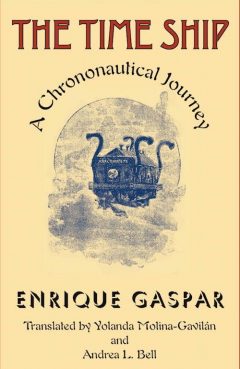The Time Ship: A Chrononautical Journey

Release Date: //1887
Country of Release: Spain
Length:
MPAA:
Medium: Literature
Genre:
Release Message: A doctor embarks on a voyage back in time, accompanied by a motley crew of French prostitutes and Spanish soldiers, to track down the imprisoned wife of a third-century Chinese emperor, believed to possess the secret to immortality. Written by Enrique Gaspar.
Description: First to introduce a time machine, originally written as a zarzuela in 1881, released as a novel in 1887. H. G. Wells wasn't the only nineteenth-century writer to dream of a time machine. The Spanish playwright Enrique Gaspar published El anacronÑpeteñHe who flies against timeîeight years before Wells's influential work appeared. The novel begins at the 1878 Paris Exposition, where Dr. Don Sindulfo unveils his new inventionwhich looks like a giant sailing vessel. Soon the doctor embarks on a voyage back in time, accompanied by a motley crew of French prostitutes and Spanish soldiers. The purpose of his expedition is to track down the imprisoned wife of a third-century Chinese emperor, believed to possess the secret to immortality. A classic tale of obsession, high adventure, and star-crossed love, The Time Ship includes intricately drawn illustrations from the original 1887 edition, and a critical introduction that argues persuasively for The Time Ship's historical importance to science fiction and world literature. Published in 1887 in Barcelona, El anacronÑpete (a neologism for "who flies against time") is one of Gaspar y Rimbau's most important works. It is a Spanish science fiction novel. This predates the publication of The Chronic Argonauts by H. G. Wells in 1888, his first story involving time travel using a machine. The novel, in the format of a zarzuela, is the first to feature a machine that travels through time: the 'anacronÑpete'. The anacronÑpete is an enormous cast iron box, propelled by electricity, which drives four large pneumatical devices ending in tubes for travel, as well as powering other machinery, including something that produces the GarcÕa fluid, which causes the passengers not to grow younger as they travel backwards in time. The machine's interior also contains all kinds of conveniences including, among other marvels, brooms that sweep by themselves. The machine provided the setting for a story in three acts, in which the following group of characters travel in time: don Sindulfo GarcÕa, a scientist from Zaragoza and the inventor of the device; his friend and assistant BenjamÕn; Clarita, don Sindulfo's niece and ward; a maidservant; Captain Luis, Clarita's beloved; several Spanish hussars; and a number of old French women of 'loose morals' that the mayor of Paris wants to rejuvenate so that they "regenerate" themselves. In the first act, don Sindulfo explains his theory of time: it is the atmosphere that causes time as demonstrated by the conservation of food in hermetic cans. By flying fast against the rotation of Earth, the machine can "undo" the passing of days (a device often mistakenly thought to be used in the film Superman). They leave Paris, from the World's Fair of 1878, and travel to the Battle of Tetuàn in 1860. Luis's troop of hussars, that Clarita expected would protect her against Sindulfo, has become children and disappear since they were not protected by the "fluid of inalterability". The machine departs, returning to Paris the day before they left, whereupon several 'rejuvenated' French girls disembark. In the second act, they again travel into the past, seeking the secret of immortality, stopping at various moments in history, such as the Granada in 1492, where they recommend Queen Isabella to listen to a Genovese and Ravenna in 690 (to obtain provisions). They end up in Ho-nan, China in 220, where Sindulfo expected that he could force Clarita to marry him. The emperor Hien-ti shows the travellers that many inventions such as the printing press and iron ships were already known. Since his empress Sun-Che has just died, he offers to exchange Clarita for the secret of immortality. The empress had actually been buried alive by his husband and happens to be the original of a Chinese mummy Sindulfo had bought and brought into the machine. Thus, she becomes free and wants to marry Sindulfo. The characters have evolved, with BenjamÕn becoming obsessed with eternal life, don Sindulfo crazy with jealousy over Clarita, and Clarita in love with Captain Luis. BenjamÕn discovers that the disappearing hussars had reappeared again because their immortal spirits had not left the anacronÑpete and that Sindulfo's first wife was the same as the empress through metempsychosis. While they leave, Tsao Pi founds the Ouei dynasty. In the third act, after a stop in Pompeii at the time of Vesuvius' eruption in the year 79, they arrive in the 30th century BCE, the time of Noah. There they discover the secret of eternal life is God. Finally, don Sindulfo in his madness speeds up the anacronopede, which explodes upon arriving at the Day of Creation. Don Sindulfo wakes up. He has slept while watching a theatre play by Jules Verne, with the just-married Luis and Clarita.